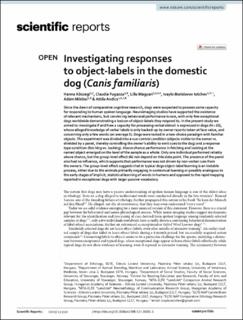| dc.contributor.author | Kőszegi, Hanna | |
| dc.contributor.author | Fugazza, Claudia | |
| dc.contributor.author | Magyari, Lilla | |
| dc.contributor.author | Iotchev, Ivaylo Borislavov | |
| dc.contributor.author | Miklósi, Ádám | |
| dc.contributor.author | Andics, Attila | |
| dc.date.accessioned | 2024-02-21T10:10:05Z | |
| dc.date.available | 2024-02-21T10:10:05Z | |
| dc.date.created | 2023-06-07T10:04:14Z | |
| dc.date.issued | 2023 | |
| dc.identifier.citation | Kőszegi, H., Fugazza, C., Magyari, L., Iotchev, I. B., Miklósi, Á., & Andics, A. (2023). Investigating responses to object-labels in the domestic dog (Canis familiaris). Scientific Reports, 13(1), 3150. | en_US |
| dc.identifier.issn | 2045-2322 | |
| dc.identifier.uri | https://hdl.handle.net/11250/3118942 | |
| dc.description.abstract | Since the dawn of comparative cognitive research, dogs were suspected to possess some capacity for responding to human spoken language. Neuroimaging studies have supported the existence of relevant mechanisms, but convincing behavioral performance is rare, with only few exceptional dogs worldwide demonstrating a lexicon of object-labels they respond to. In the present study we aimed to investigate if and how a capacity for processing verbal stimuli is expressed in dogs (N = 20), whose alleged knowledge of verbal labels is only backed-up by owner reports taken at face value, and concerning only a few words (on average 5). Dogs were tested in a two-choice paradigm with familiar objects. The experiment was divided into a cue-control condition (objects visible to the owner vs. shielded by a panel, thereby controlling the owner’s ability to emit cues to the dog) and a response type condition (fetching vs. looking). Above chance performance in fetching and looking at the named object emerged on the level of the sample as a whole. Only one individual performed reliably above chance, but the group-level effect did not depend on this data point. The presence of the panel also had no influence, which supports that performance was not driven by non-verbal cues from the owners. The group-level effect suggests that in typical dogs object-label learning is an instable process, either due to the animals primarily engaging in contextual learning or possibly analogous to the early stages of implicit, statistical learning of words in humans and opposed to the rapid mapping reported in exceptional dogs with larger passive vocabulary. | en_US |
| dc.language.iso | eng | en_US |
| dc.publisher | Springer Nature | en_US |
| dc.rights | Navngivelse 4.0 Internasjonal | * |
| dc.rights.uri | http://creativecommons.org/licenses/by/4.0/deed.no | * |
| dc.title | Investigating responses to object-labels in the domestic dog (Canis familiaris) | en_US |
| dc.type | Peer reviewed | en_US |
| dc.type | Journal article | en_US |
| dc.description.version | publishedVersion | en_US |
| dc.rights.holder | The authors | en_US |
| dc.subject.nsi | VDP::Matematikk og Naturvitenskap: 400 | en_US |
| dc.source.volume | 13 | en_US |
| dc.source.journal | Scientific Reports | en_US |
| dc.source.issue | 1 | en_US |
| dc.identifier.doi | 10.1038/s41598-023-30201-1 | |
| dc.identifier.cristin | 2152490 | |
| cristin.ispublished | true | |
| cristin.fulltext | original | |
| cristin.qualitycode | 1 | |

